Reviews
The Amazing, Shape-Shifting Brian Eno Doc, and the Meaning of Generative Art
'Eno,' directed by Gary Hustwit, is a film about an artist and also a work of art all by itself. Truly.

'Eno,' directed by Gary Hustwit, is a film about an artist and also a work of art all by itself. Truly.

Ben Davis

I had already seen Eno once when I crossed paths with my friend Daniel Bachrach coming out of Film Forum, fresh from his own screening of this exceptional experimental documentary about the legendary musician, producer, and thinker Brian Eno. We both loved the film, and were eager to swap notes. What was his favorite part? “It has to be the ‘frog’s eye’ segment,” Daniel said.
That bit wasn’t in the version I had seen, a fact that seemed astounding to Daniel. “It’s the best explanation of minimal music—and it takes him four sentences.”
I wouldn’t see that particular footage until my next screening. As promised, it’s one of those Eno observations that states something very simply, but makes you think in a new way: He describes something he read on frog vision, how frogs evolved so that their eyes tune out anything that doesn’t change, which seems like an evolutionary weakness. Yet it serves them, because it makes them more attuned to even the small movements that aren’t static: the flies. This helped Eno think about a particular effect you could get with music, how insistent repetition has the effect of lulling you—your brain tuning out the sound—but that against this foundation of familiarity, you suddenly notice even the small details that break away from the pattern in a newly vivid way.
It’s a great observation about music. It’s also a nice lens through which to look at this particular film. Because in some ways, Eno itself fits the very familiar template of a musical bio-doc—the artist talking about his work, paired with footage of career highlights, of which there are many for Eno. But the very fact that it works so well on this familiar level actually makes what’s different about it sing out all the more.
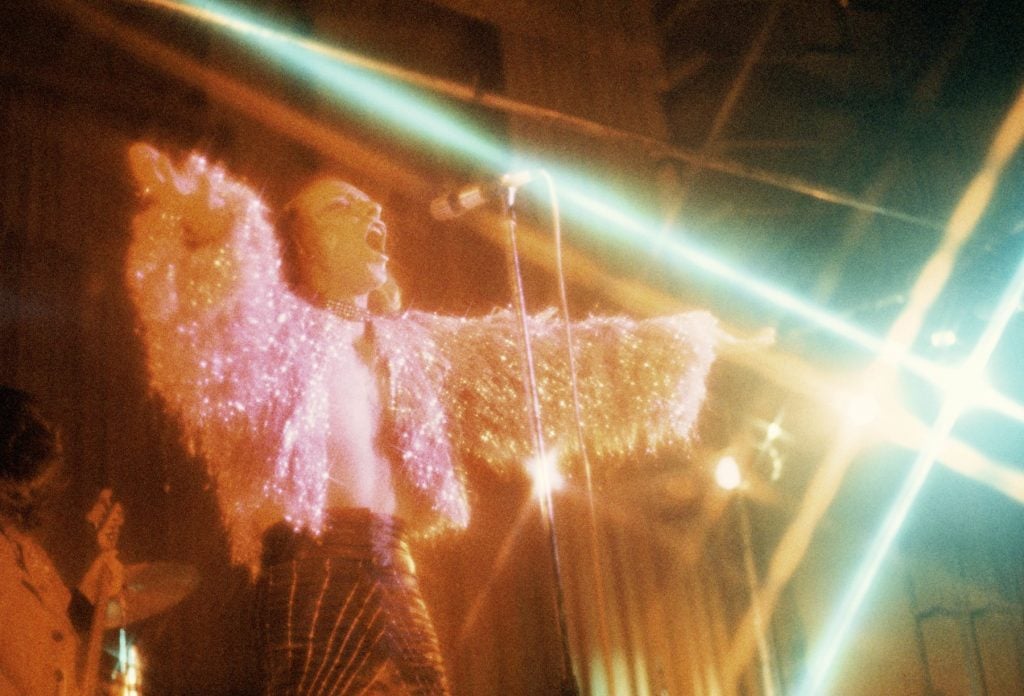
Brian Eno performing on stage during Roxy Music’s “For Your Pleasure Tour.” (Photo by David Warner Ellis/Redferns, via Getty Images)
Because Eno is also a generative work of art all on its own, a documentary that, thanks to the magic of a technology called Brain One (an anagram of “Brian Eno”), changes each time it is screened.
I’ve seen Eno three times now. I love Brian Eno, so this was not a chore, and I can say that each version contained incidents that probably would be central to this or that telling of Eno’s career that the other two versions didn’t include. Only the first version I saw contained Eno explaining the kinds of hopes he invested in ambient music’s social function, using the anecdote about how Discrete Music (1975), his first ambient album, helped David Bowie kick his coke habit.
Only the second contained Eno recounting how he secretly peed in Marcel Duchamp’s Fountain, a puckish gesture that he viewed as a statement that the artwork’s original rebel message has been lost, and that he called, in a joke on “decommodification,” an act of “re-commode-ification.”
Only the third contained Eno’s full account of the creative process of songwriting, framed by some amazing footage of Eno in the studio with a baby-faced U2, riffing and improvising its way to the birth of the 1984 anthem “Pride (In the Name of Love).”
“A lot of rockstars went to art school,” Bono says. “Eno was our art school.”
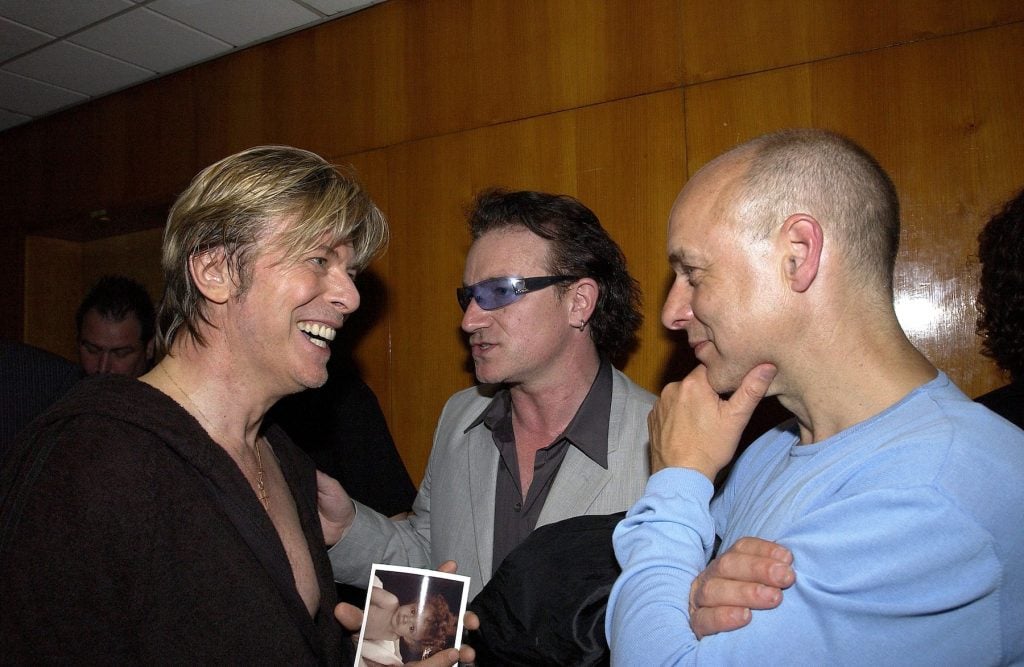
David Bowie with Bono and Brian Eno (Photo by Brian Rasic/Getty Images)
Since these segments are all highlights of Eno, the film raises the question for me about what I am really reviewing when I review a generative artwork of this kind: each of the individual manifestations or the whole experience of seeing it repeatedly, in aggregate? While the generative-art gimmick fits the subject of Brian Eno, who is nothing if not experimental and has much to say about how embracing chance can produce new ways of making, the film’s director, Gary Hustwit, has made it clear that he is demo-ing a technology he wants to become much more common (including the threat of generative Marvel films) and that he pictures it as a way to treat film as a live event, remixed for any audience’s tastes.
Hustwit is an admirable filmmaker—I loved his Helvetica (2007), the best doc ever made about a font, and he’s made a gutsy decision to distribute Eno independently, on his own terms. But in less sensitive hands, it’s not hard to imagine a downside to the ever-remixed model of film. Anyone who knows the words “Han Shot First” (or, worse, “Maclunkey”) knows the peril of a director refusing to let a beloved movie be. Film is a collective art. Part of what makes it so is that it provides a fixed set of symbols that people can refer back to together.
Some early harsh press for Eno, I think, was implicitly inspired by the fact that it is being debuted at a time of immense irritation and anxiety about A.I., with its combination of hyperbolic claims and slop output. People hear “generative film” and they now immediately think of creative decision-making being replaced by a bland corporate chatbot.
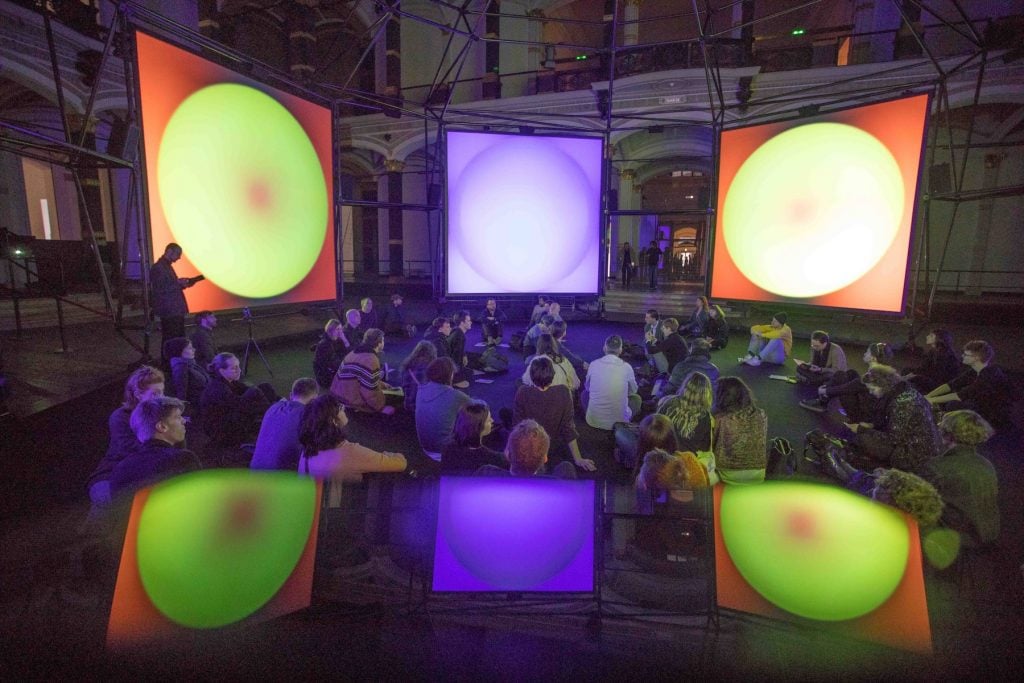
The installation Empty Formalism by Brian Eno in the “ISM Hexadome” in the Martin Gropius Building in Berlin. Photo by Jörg Carstensen/picture alliance via Getty Images.
Yet, while it is novel for cinema specifically, one can overstate how threateningly novel the generative-art idea is when it comes to culture in general. The idea of “generative film” brings to mind “Generative A.I.,” the current subject of bubble levels of hype—but what’s happening here is really different, technically. So another term I might use to describe Eno would be to say that it is a “rogue-like” film. This is a common term for video games that don’t have fixed level design, but that generate a new environment every time you play, à la the 1980 dungeon-crawler Rogue.
I’ve spent more hours than I care to admit playing rogue-like (or, to be strictly accurate, “rogue-lite“) games like Dead Cells (2018) or Hades (2000). The procedurally generated level design does, indeed, create a game you want to play over and over again, even after you have beat it once—just the way that I probably wouldn’t have gone to see Eno three times were it not for the gimmick.
But over time, you do get to know these games. Environments change, but you learn that there are certain kinds of things that you can expect, and certain things that will never happen. In the course of getting to know the game, you feel out what its shape is, without ever experiencing every variation, sort of like getting a mental picture of a space while blindfolded. Or, to use a different metaphor that’s maybe a little more appropriate, you get a sense of its personality.
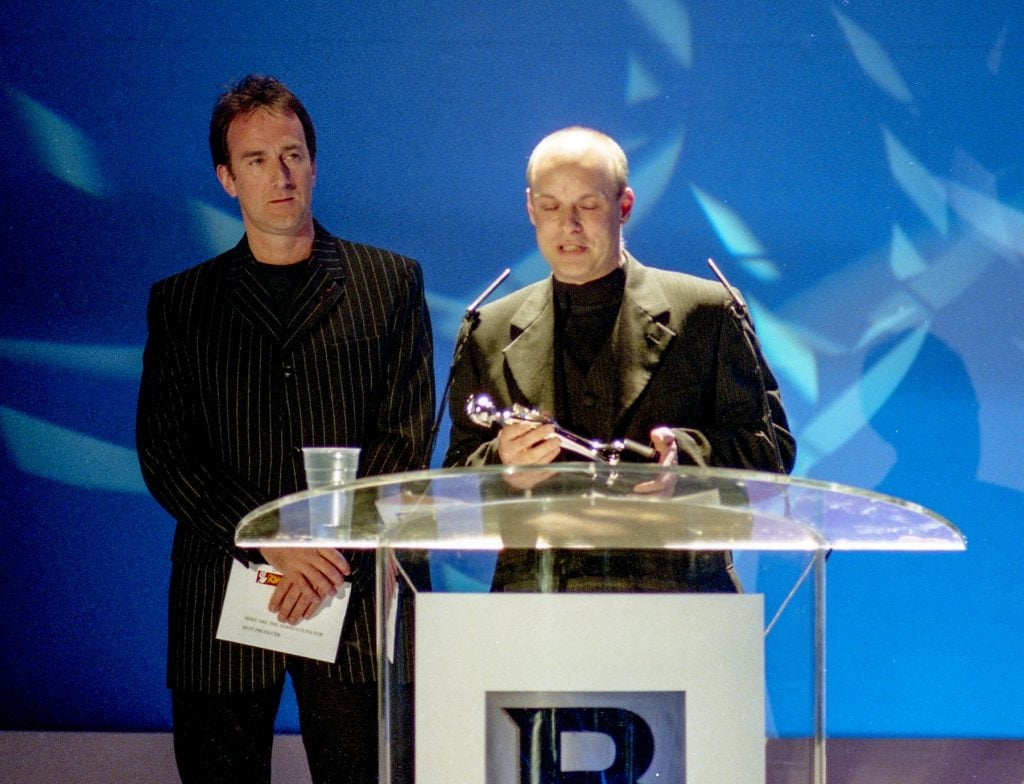
Brian Eno wins Best British Producer presented by Angus Deayton during The BRIT Awards 1996. (Photo: JM Enternational, courtesy Getty Images.)
I’ve come to think that “personality” is the key concept in judging generative art. In terms of a collective experience beyond that single playthrough or screening, even when the local details differ, you obviously still share references with everyone else: the experience of what doesn’t vary and what does, and how much variation you expect—an artwork’s moods and their range.
Admittedly, to say that you are looking at an artwork for its “personality” is also to say that you might catch it on better or worse days. I think the third time I saw Eno was the best, for me; the second was the worst. But I’ve also seen enough to say that as an artwork, Eno definitely has a stable personality—the tone is consistent, and consistently affecting. Hustwit drew from 30 hours of interviews with Eno and 500 hours of archival footage. I imagine that it is very, very difficult to assemble all the parts and to weight all the probabilities to generate this consistent personality—it is likely more labor, not less.
I’ve already mentioned what was different in the different screenings of Eno, but a lot was the same each time—maybe two-thirds, maybe more.
All three versions, for instance, had a monologue by Eno, towards the beginning, about his earliest memories of being moved by culture, of hearing the voice of singer Ketty Lester as a teenager, being turned on, and thinking that this voice, along with a certain purple color and the feeling of walking along the boardwalk at sunset, were the three most important feelings in the world—things that he wanted to hold onto. It’s a wistful, personal anecdote that makes sense as something that Hustwit would want to appear often in the film, as an orienting beat. It conveys the intersecting interests in sex and music, art and nature, that run through the story his doc is telling about Eno. (It seems important to Eno himself, too: a reference to Lester appears in the lyrics to the gorgeous song, “All I Remember,” that plays over the credits of the film—and god, the opening couplet of that song makes me well up every time.)
But many of the details that repeated in all the Enos I saw had no giant significance. They were really small, human moments—moments, even, that another filmmaker might have cut. The sexy set-pieces that the public knows—Roxy Music, Bowie, U2, Devo, Talking Heads, Laurie Anderson, John Cale, the Microsoft “startup” sound—actually varied more in terms of whether they appeared or not. But every time I saw it, Eno began with Eno in his garden, recounting that he had seen a cluster of beetles gathering on the leaf of a plant.
Every time, it had him in his studio, showing the filmmakers his favorite YouTube videos, and cursing as he can’t mute the preroll ad for Grammarly fast enough (very relatable).
And every time, there’s him in the park, toward the end, talking about how hungry he is, and jokingly cursing the dog-walkers that converge on his spot to disrupt his thoughts.
Over the course of my viewings of Eno, I went from barely thinking about these little moments, to noticing their repetition and thinking of them as filler, to seeing how important they are. They subtly ground the movie’s message, which is that creativity’s taproot is being alive to parts of experience we tune out.
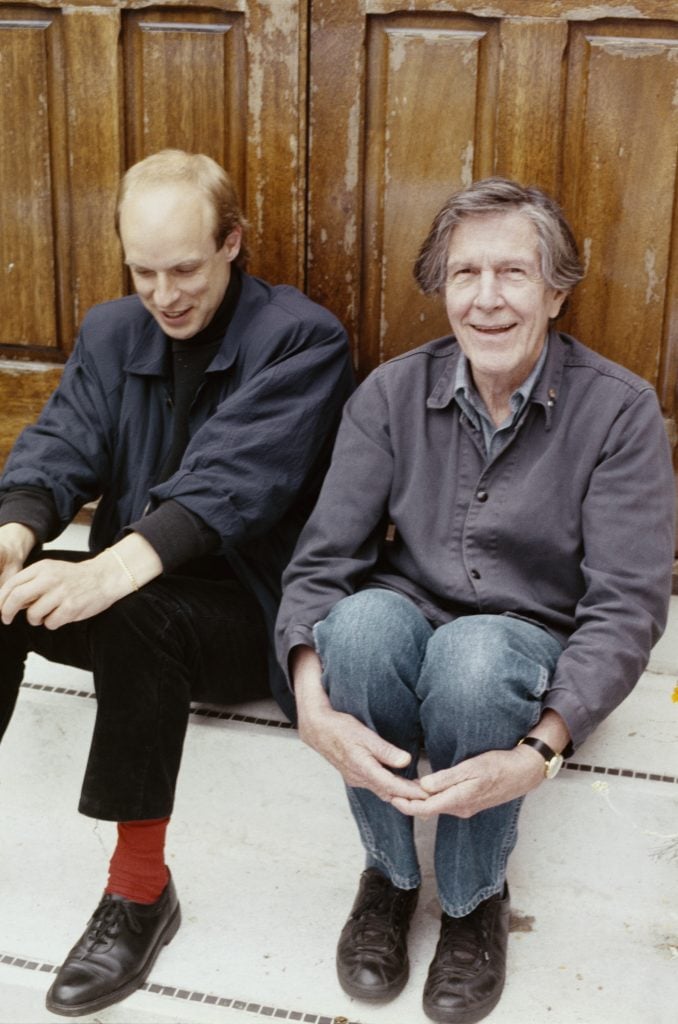
Brian Eno with John Cage, May 1985. (Photo by Michael Putland/Getty Images)
This is not to deny that the film’s highs aren’t actually true highs. When you see Eno a few times, all those brilliant moments of pop history are like those sparks of movement the frog sees better against the stable background—you feel how extraordinary they are all the more because they don’t always appear.
I disagree with the New York Times’s Alissa Wilkinson, who says in her review of Eno that the film had a different message every time, that Hustwit assumed that the audience would fill in a sense of coherence that isn’t there. This was not my experience. It may vary in other showings, but the film I saw had a clear flow in all three of its permutations, beginning with Eno talking about formative musical inspirations and ending with him talking about the fragile environment—a subject of deep concern for him—and what it means to make something of our time on earth.
Most importantly, in every incarnation I saw, it was a philosophical movie.
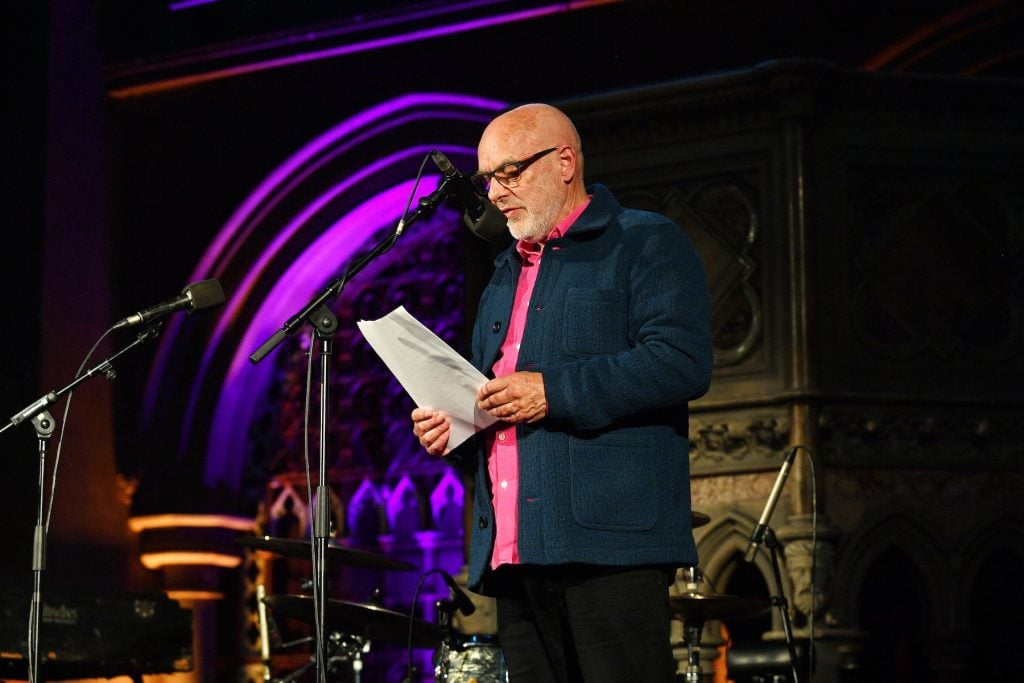
Brian Eno speaks during SUMUD, a fundraising event for Palestine, organised by the Amos Trust, at Union Chapel on April 18, 2024 in London, England. (Photo by Jim Dyson/Getty Images)
I should correct something I said at the top. Hustwit’s Eno could pass as a normal bio-doc about Brian Eno, and it certainly takes advantage of all the famous figures he has intersected with, but it is something a little more. Were it presented as a recounting of just him as an individual, then perhaps I would feel more was missing when this or that famous incident failed to appear. But it focuses on his thoughts on the body and the brain, creative control and creative surrender—always. Whatever path through his life is pulled, what you see is him thinking through the creative process and constantly talking about the bigger meaning of his experiences.
The strength and generousness of the ideas are what hold Eno together across its many possible iterations. Which is maybe also just to say that, because personality is important in generative art, it does help to have a personality as vital as Brian Eno’s at its center.